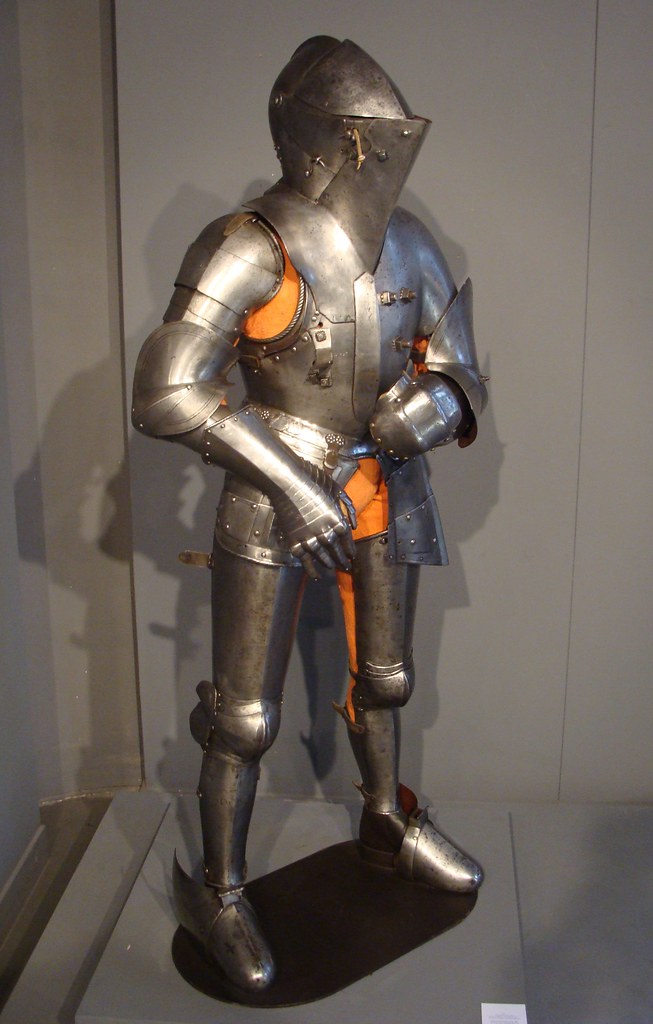bffb Medieval Period, Medieval Knight, Medieval Armor, Medieval Fantasy

Pin auf Armor 12001700
Sixteenth Century Breastplate Shapes Allen Antiques This page illustrates a set of different breastplate shapes that existed during the 16th c. All of the examples were taken from the Allen collection. The first three illustrate a form that was used in the late fifteenth century and into the second decade of the sixteenth.

A series of sharp but also intermittent conflicts broke out over
October 2004 At the turn of the fifteenth to the sixteenth century, one of the most startling changes in taste and fashion occurred, which was immediately mirrored in armor and can best be witnessed in the German harness of the period.

Century armor, Battle armor, Ancient armor
October 2003 Some of the earliest decorated armor was produced during the Celtic Bronze Age in Great Britain and Ireland, Scandinavia, and the area of modern-day France, Germany, and Austria.

Italian Armor Armor, 16th century, Martial arts
This decorative armor exquisitely replicates the famous 16th century Milanese style of armor. This suit features a marvelous men at arms style helmet with working visor. The chest plate features an exceptional relief-style shield emblazoned with the coat of arms for the famous Medici family. The armor is handcrafted in Italy from aluminum for a.

Soldiers of the Italian Wars Late 15thEarly 16th Century Century
Cologne was known for the manufacture of fine swords and mail armor from at least the twelfth century. The names of Passau and Solingen were synonymous with sword blades: the famous Passau "trademark"—a running wolf incised on the blade—signified such exceptional quality, that during the fifteenth century, Solingen blade smiths began to copy the mark and apply it to their own blades.

late 16th century armour for the 'Italian til… Flickr
Renaissance. The Renaissance collections bring together masterpieces of northern and southern European art from the late 1400s to the early 1600s. Monumental sculptures, rich textiles and colourful ceramics show artists' continued fascination with the art of the Roman world and the importance of the Christian church as patron.

Italian armor plate armor 16th 17th century 15001600 Brest plate and
Desiderius Helmschmid, German, documented 1513-1579, Equestrian Armor of Emperor Charles V, Augsburg, c. 1535-1540 (lance, 16th-19th century) etched, embossed, and gilt steel, brass, leather, fabric (lance: steel and wood), Patrimonio Nacional, Real Armería, Madrid 1 of 51 Create memories with art This giving season, join us in sharing art

bffb Medieval Period, Medieval Knight, Medieval Armor, Medieval Fantasy
Black and white armour is a different term, for late 16th and 17th century armour that uses a contrast between highly burnished "white" and unpolished "black" areas for decorative effect in large bold patterns over the armour. See also Predecessors Brigandine Transitional armour Successors Milanese armour Kasten-brust armour References
Fashion in European Armor Essay The Metropolitan Museum of Art
Armour design and armourers thrived in the first half of the sixteenth century. This was due to one central conflict that raged throughout Europe during the first sixty years of that century: the Habsburg-Valois Wars, also better known as the Italian Wars (1494 - 1559).

Medieval 16th Century GermanItalian Jousting Armour Ancient armor
Hill describes Italian fashion at the start of the 16th century, writing that: "Sleeves became voluminous, and the arm opening dropped off the natural shoulderline emphasizing long necks and long, cascading hair. In the military fashion, doublets were commonly cropped at the waist to which the hose was attached." (354)

italian armor Tumblr Knight In Shining Armor, Knight Armor
This late 15th-century suit of Italian plate armor covers the entire body. During the late 15th century and the early 16th century the art of the armorer reached its peak.. (1470-1555) and Hans's son Jörg (c. 1505-80). During the 16th century, when plate ARMOR had become ceremonial rather than practical, the family made richly elaborate.

15th Century Arms Armor Century armor, Historical armor, Medieval armor
Catherine de' Medici, Queen of France, wears the more traditional French hood in a 1559 portrait (Fig. 8). Her dress conforms to the same rigid silhouette seen at the English court based on the Spanish farthingale and the beginnings of corsetry, as Millia Davenport explains in The Book of Costume (1948), writing that her: "gown is of black velvet, embroidered with gold and lines of pearls.

1000+ images about 17 Century Armor on Pinterest Auction, Armors and
Armor attributed to Richard Holden Dirk H. Breiding Department of Arms and Armor, The Metropolitan Museum of Art October 2004 Dictated by functionality rather than fashion, armor fell into gradual decline during the seventeenth century, first in quality, later also in quantity.

Antiques Atlas 16th Century Milanese Italian Half Armour
Indeed, many Italian workshops produced armor made specifically for export in the fashion worn in Germany (alla tedesca) or France (alla francese). At about mid-century, Italian armorers began producing armor all'antica: armor imitating (or thought to imitate) arms and armor of the style used by the heroes of classical antiquity. "Muscled.

A composite etched north Italian corset, late 16th century. Armaduras
A Japanese 16th-17th century suit of plate armour with a western-style cuirass ( nanban dō gusoku) In the Kofun period (250-538), [4] iron plate cuirasses ( tankō) and helmets were being made. [5]

Italian knights, the 15th century. Средневековье, Средневековые
World History Encyclopedia. World History Encyclopedia, 19 Jul 2022. Web. 08 Jan 2024. Advertisement Typical weapons and armour used in European warfare in the 16th century and by conquistadors in the New World. (Grand Master's Palace Armoury, Valletta, Malta)